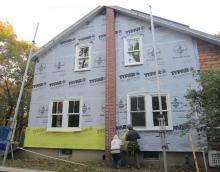Building envelope
Widening the Circle in High Performance Residential Design
On Eggshells: Residential Retrofits in Tricky Situations
Benefits of Cx and RCx: Compliant Buildings, Healthy People
Airsealing and Firestopping: Smart Science
Lighting = Cash + Code
Tuesday Workshop - Managing Moisture to Achieve Long-Life and Low-Maintenance
Designing for durability is essential for green buildings, because if you double the life of a building, regardless of construction type, you halve the environmental impact of its construction. In the design of buildings and building components to achieve long-life, moisture must be managed and understood, including the ability to have effective and efficient maintenance and repair. Drawing upon decades of hands on experience, two building scientists will present the nitty-gritty of good design that embraces and understands moisture.
Tuesday Workshop - Introduction to Building Science and Diagnostics
This overview of residential energy efficiency is appropriate for future auditors, would-be retrofitters, and anyone else who lives in a house. It starts with the basics of heat, air and moisture flow. Various insulation and air sealing materials are discussed. Heating fuels, heating systems, and hot water systems are compared. Common building performance problems and their solutions are outlined. There is a brief description of blower door testing and related diagnostics, along with suggestions for prioritizing recommendations.
Tuesday Workshop - Net Positive Energy: Power and the Living Building Challenge
The Living Building Challenge Energy Petal is intended to signal a new age of design, wherein the built environment relies solely on renewable forms of energy and operates year round in a pollution-free manner. In this in-depth review of the Energy Petal, participants will gain an understanding of how to create Net Zero Energy buildings. This interactive session will present detailed case studies of several Net Zero Energy certified buildings - identifying the design and operational challenges these projects had to overcome to meet their Net Zero Energy goals.
Tuesday Workshop - Here Comes the Sun (Again)
In a cold climate, the sun is a commodity not to be ignored. In 2014 engineer Marc Rosenbaum gave you the master's session. This session comes from the perspective of a designer who also works to integrate the sun in all aspects of design. High performance, energy efficient buildings should take advantage of what the sun provides. Designing in concert with the sun can bring comfort and beauty to the experience of being in a space. This session explores various ways residential design and construction can benefit from the sun's energy.
Tuesday Workshop - Diagnosing and Airsealing Large Commercial and Institutional Buildings
If you want to get your large commercial or institutional project to meet your savings number, exceed energy performance goals, or get your label, you need to perform targeted air leakage diagnostics and actually fix the leaks. There are numerous other reasons to retrofit a building’s envelope including comfort, humidity control, infestations, component degradation or simply being able to control a building. Larry Harmon, a national expert in this field, will take you through millions of square feet of buildings that he has diagnosed and fixed over the last few years, sharing practical sol

